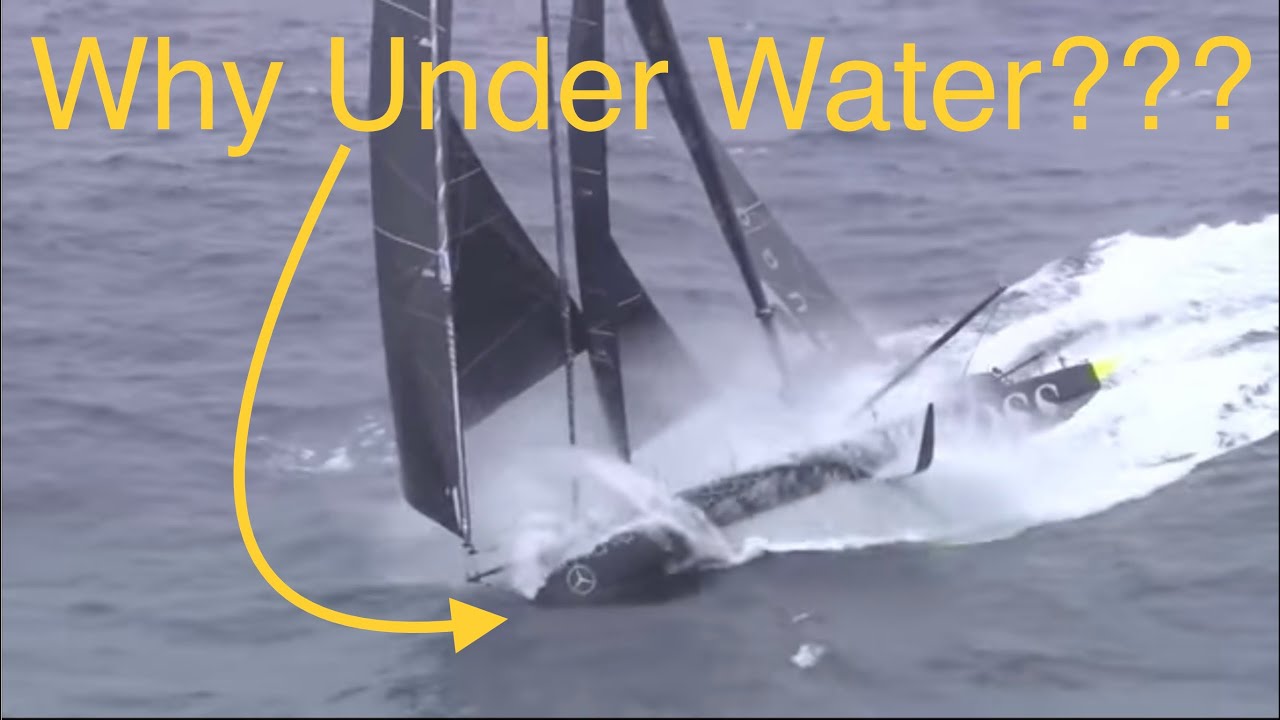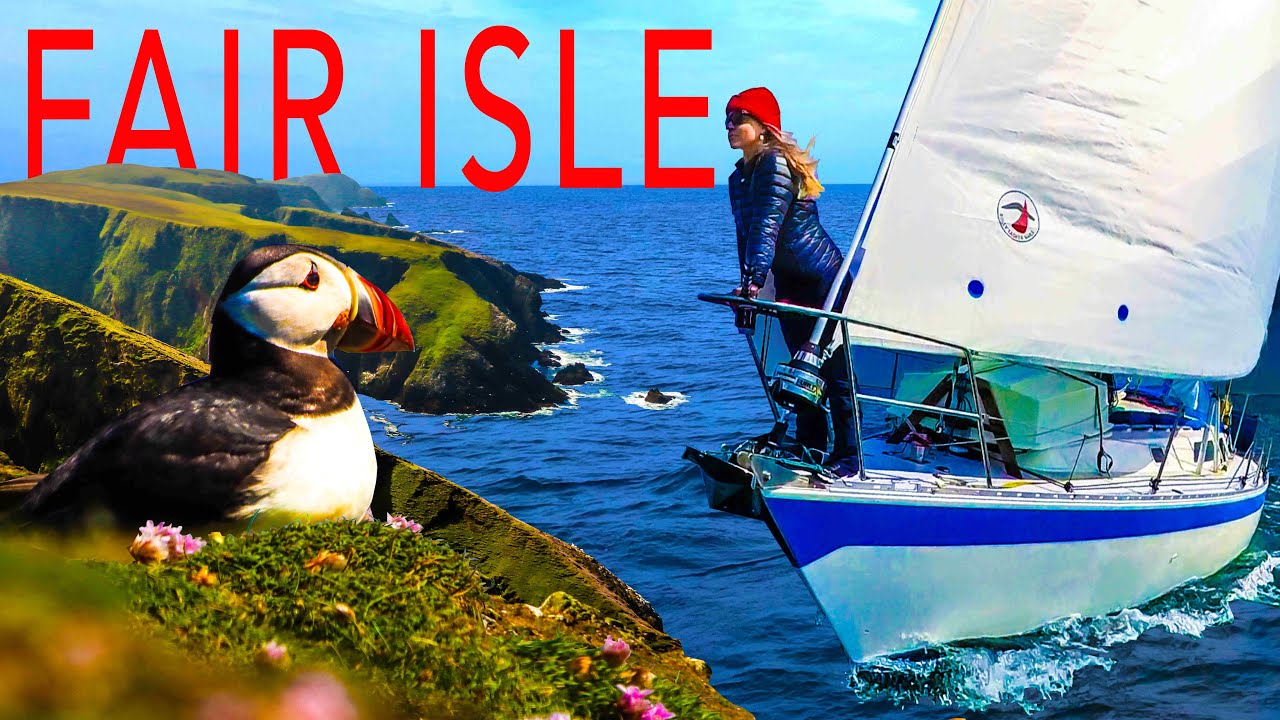V-ați întrebat de ce Hugo Boss al lui Alex Thomson este adesea sub apă, sau de ce are acel arc răsturnat sau dacă ar fi mai rapid cu un arc tradițional și mai puțină apă pe punte? În videoclipul de astăzi vom răspunde la toate aceste întrebări. S-ar putea să fiți mai familiarizați cu un arc tradițional, care este cel mai comun design găsit pe iahturile cu vele. Oferă mult spațiu în interiorul bărcii, pentru danele în V sau depozitarea ancorei, asigură o călătorie relativ uscată, deoarece deviază spray-ul de pe punte și înapoi spre apă și oferă un loc convenabil pentru montarea și lansarea unui ancora, fără a fi nevoie să vă faceți griji cu privire la ancoră sau să călăreți lovindu-se de carenă. Cel mai notabil dezavantaj este viteza. Capacitatea unei ambarcațiuni cu vele de a merge mai repede este direct proporțională cu lungimea liniei de plutire. Dar, cu o prova evazată, aveți o lungime a bărcii care nu este în apă, care nu contribuie la viteza dvs., dar tot trebuie să plătiți pentru aceasta cu acostarea anuală, deoarece portul de agrement percepe de obicei lungimea totală, indiferent de lungimea. este folosit pentru. Pentru a maximiza lungimea și viteza liniei de plutire, multe bărci de curse folosesc arcuri cu plumb. Un arc cu plumb este drept în sus și în jos, așa cum ar atârna un plumb de partea din față a bărcii. Pentru o anumită lungime a bărcii și toate celelalte lucruri fiind egale, o barcă cu un arc plumb ar fi mai rapidă decât aceeași barcă cu o prova evazată. Dar constructorii trebuie să fie, de asemenea, puțin mai creativi în a oferi locuri pentru lansarea și depozitarea ancorei, deoarece aceasta poate lovi prova în coborâre. De asemenea, arcurile cu plumb nu sunt la fel de bune la devierea spray-ului înapoi în apă, așa că s-ar putea să ajungeți cu mai multă pulverizare în aer, mai multă apă pe punte și un echipaj puțin mai umed, dar pentru concurenți merită un pic de umezeală. viteza. Majoritatea bărcilor își vor bate prova prin valurile care merg în sensul vântului și nu este chiar mare lucru, deoarece barca și valurile merg în direcții opuse, valul trece destul de repede și apa de pe punte se revarsă înapoi în ocean. Dar vântul este o altă chestiune. O barcă rapidă va urca pe partea din spate a unui val, va merge peste vârf și va accelera în jos pe față. În funcție de abruptul valului, arcurile se vor scufunda puțin când vor întâlni spatele valului următor. Un pic nu este o problemă, dar dacă prova se scufundă complet, puntea poate acționa ca o linguriță și poate încetini dramatic barca. Acest lucru face ca vântul aparent să se balanseze spre pupa în același timp în care valul din spate ajunge din urmă cu barca, ceea ce poate face ca barca să se răstoarne sau să se răstoarne, ceea ce chiar nu îți dorești. În schimb, doriți un arc care are mai mult forma unui cuțit inversat, care poate tăia cu ușurință drumul înapoi până la suprafață atunci când se scufundă. Disclaimer: – Acest conținut este oferit exclusiv pentru educația și divertismentul dvs. – Nu există garanții, exprese sau implicite, cu privire la orice conținut sau potrivirea acestuia pentru un anumit scop. – Există riscuri de rănire, deces, beție și dificultăți financiare implicate în navigație. – Comandantul este întotdeauna responsabil pentru siguranța navei și a echipajului său. – Sailing Tips nu este responsabil sau răspunzător în niciun fel pentru orice se întâmplă pe sau oriunde în apropierea ambarcațiunii dvs. sau a oricărei ambarcațiuni pe care nu suntem în comandă. #sailing #invertedbow #howtosail #learntosail #sailingtips
source
De ce Hugo Boss al lui Alex Thomson este adesea sub apă?!?!?

44 thoughts on “De ce Hugo Boss al lui Alex Thomson este adesea sub apă?!?!?”
Comments are closed.




Great vid. Something about Hugo Boss, Mercedes’ and all black livery gives me a 1930’s feel.
Tak jakby lekko nieświeże wiadomości i wnioski. O puntach (pustakach) jeszcze nie słyszałeś?
A displacement hull always will work it's way down into the water because of the hydro vacume that has a hull speed that it can't overcome. I sailed a Morgan 40' in a 20 kt wind under full sail and it made a hole in the water the faster it went ( keel boats won't get up and plane away AT ALL).
I bet that by theory a keel boat would eventually be swallowed whole by the water if pushed hard enough.
Great stuff. I just learned something!
AWESOME
Who knew? That was fantastic
Length at the waterline is only helpful for speed for displacement vessels like a typical monohull. Hugo Boss is a planning vessel and diving under the waves in no way helps them go faster. Even you say they go slower at one point. Here is a current video (https://www.youtube.com/watch?v=seRWRAnEj8c) from The Ocean Race 2023 with two boats fighting out this very point. They boat that keeps it's bow out of the water, the boat that stays above the waves and even shortens it's length at the waterline by more than 50% is much faster than the boat with additional drag. AKA Maritiza beats 11-hour for this exact reason. Maximizing the waterline length is exactly backwards of what Boss would choose to do. More water = more drag. Many of your other statements are correct about pitching but your main point seems off the mark IMO. Love most of your other videos.
Because it is a sailing submarine!
Well that just answered my question while designing a all weather enclosed sailboat…
Prawda korespondencyjną, dotarła, ale teorii prawd znam tylko 10 i wariacje 😉
Imagine having boats like these made like 1000 or 2000 years ago.
Imagine the mighty naval empires seeing some crazy stuff like this and then receiving some small but highly potent flammable chemical fires shots that don't extinguish with water.
^_^
The black pearl from pirates of the carribean , rising from beneath the waves ^_^
It's much calmer under water, less bouncing up and down from those annoying waves. Unless it's kinda shallow!
2:44 What you mean is: You wanna really, really, really wanna zigazig ah
because its on the verge of sinking – you see, it has to do with the fundamentals of dragging the anchor, shipboard clarity and the galley, they have to really work together in unison you must have enough money and think of your self highly enough to stand on the bridge yelling "stroke" stroke" stroke" then and only then do you become a true matey – you see, one doesnt race yachts, the yachts race one, pushing you to your limits trying your sea bound prowess and extraordinary skills that keeps you in your own wind, and never seizing to amaze yourself –
yo ho ho, never forget the cotter pin on the propeller shaft nut if you wish to reverse you current situation " capt caveman"
always check your plug before backing down the ramp "capt mastbeam"
The "upside-down bow" is also featured on the DDG-X ships.
Very interesting.
That's how my dad's racing canoe bow is shaped. Real sketchy in bad weather when the waves almost go over the top.
Military Naval architects knew all this bow stuff more than 100 years ago. I think the reason we're only seeing it now in sailing craft is because only now has sail design made sailing vessels fast enough for it to matter.
Do racing yachts use mass dampers? If not, why not? Should work well for stabilizing the vessel in the pitch axis. They worked so well in Formula One that they outlawed. Totally passive so shouldn't come afoul of most rules. The only reason they outlawed in F1 is because Ferrari didn't invent them.
I've never seen a sail boat take a face plant befor
Old tech vs new tech … which should be faster? … ROFL
Hugo Boss was missing the starboard Foil in those shots.
Really interesting.
Cheers
Isn't it also a function of the stability of the down wings that create an up force as the overall displacement begins the "pop up" and recovery? That this functionality is part of the survivability paradigm for such seas as the Southern Ocean. That the design was dedicated to the ability to survive and go really, really fast. On the opener of the video view it appeared from the forward angle that she was a bit overcanvassed. It's a balance to keep a tremendously fast pace over ground, seakeeping and safety AND constant attention to the weather and winds and sails aloft. Good explanations for the hull shape.
I have no interest in sailing, but YT algo threw this in my feed.
Interesting since I have a fluid dynamics background.
👍
An X Bow or inverted bow sailboat would be interesting.
Can't say that I'm a big fan of the all black sails & hull.
we should go back to ancient boats xD
Hugo Boss made the SS uniforms for the Nazi's didn't they ?
How about a decent boat, like a multihull…..mono's…pffft
more importantly,
why is it named after the nazis favourite designer?
I think you are just showing off your awesome plumb bow boat model…
It is often under water, because it was originally built as an eco friendly narco sub.
Then they realized the sails make it too visible and sold it to Alex Thomson.
Sailing is so kool , i grew up boating on lake erie. No sailboats, but it is fun to sail on 1 .
You do know that there is more than one knife design????come on
When a ship sinks it's the captain's fault, unless they're in command of a badly designed vessel.
you actually think we eant to watch YOU talk???
Bad karma Hugo Boss was a designer of Nazi uniforms
@Sailling, this tech I called " #Active real-time attack angle regulation" technology. It can be used in next generation wind turbine. The core tech of next generation wind turbine is that the blades angle of each blades always can be adjusted according to the position of blade, moving speed, wind direction and wind speed.
excellent, again.
keel boats are WHALE KILLERS and you forgot scow bow or rounded bow and balanced bow-stern buoyancy design
Because the bow is not full enough. The future is full and slim in height – thickness. When the boat is under full power and is healed over the bow point will be engaged less and not slow the speed of the boat.